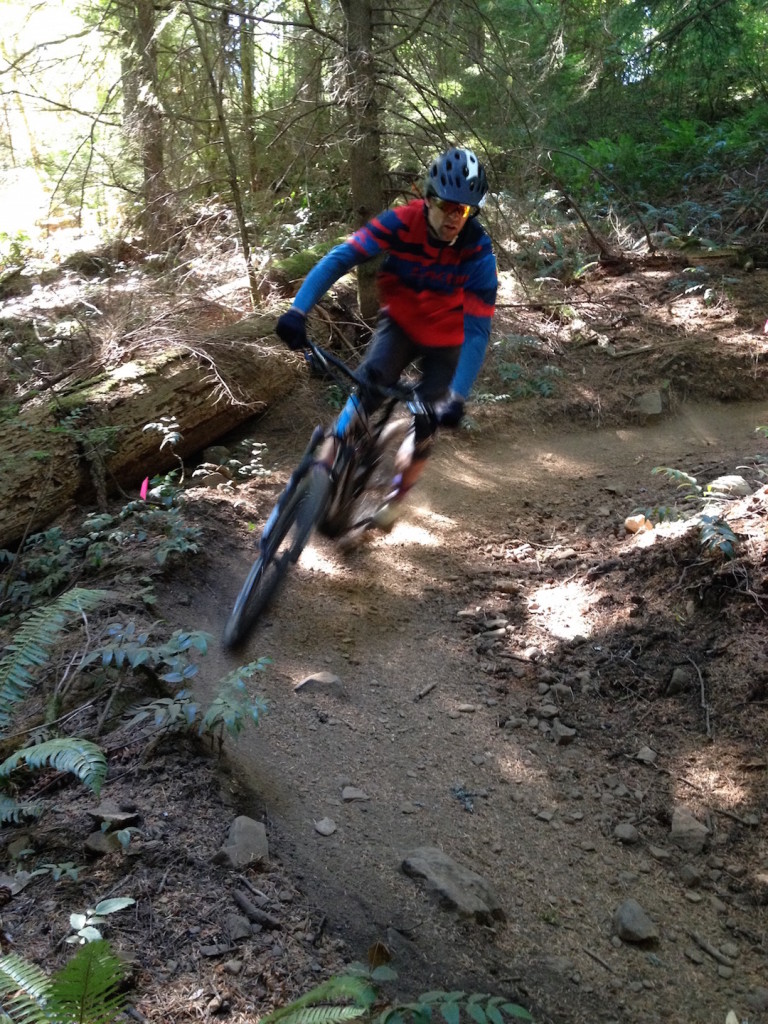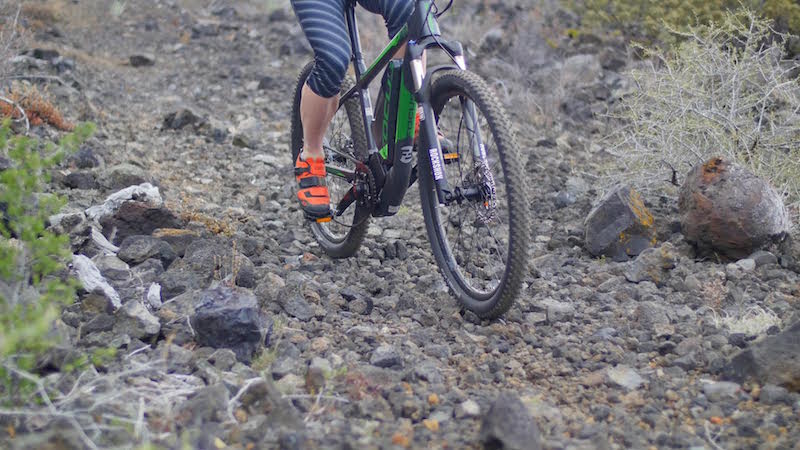The New California E-Bike Law & Electric Mountain Bikes
By Morgan Lommele, E-Bikes Campaigns Manager at PeopleForBikes.
On October 7, 2015, California Governor Jerry Brown signed A.B. 1096, legislation that clarifies the regulation of electric bicycles in California. This new law means that riding an electric bicycle on bikeways is no longer illegal in California.
The bill designates three classes of e-bikes and distinguishes lower speed electric bicycles that reach motor-assisted speeds of up to 20 miles per hour (Class 1 and 2 electric bicycles), from higher “speed pedelecs” which have motors that provide assistance up to 28 miles per hour (Class 3).
This class system allows the use of lower-speed e-bikes on bicycle paths, and also provides local authorities with the flexibility to regulate different types of e-bikes based on their needs.
This new law, effective January 1, 2016, only applies to Class I, II, III, and IV bikeways in California.
Many have asked how this affects eMTB access on trails in city, county, and state parks. The important distinction is that this law applies only to the California Vehicle Code.
State, county and city parks are managed outside of the vehicle code, just as the federal land management agencies. “Bicycle path or trail, equestrian trail, or hiking or recreational trail” is commonly used in the Vehicle Code, and is the preferred way to discuss path/trail access, even for paved or soft-surface bikeways.
In short, the Vehicle Code does not regulate trails in the State Parks. Trails are regulated separately by parks departments, which control access. This law does not clarify where eMTBs can be ridden on trails in city, county, and state parks.
In an effort to better understand the potential social and environmental impacts of eMTBs and support management recommendations for eMTB use on trails, the Bicycle Product Suppliers Association and PeopleForBikes have partnered with the International Mountain Bicycling Association (IMBA) on this research related to the expanded use of eMTBs on trails.

Photo credit: IMBA
IMBA has completed the field-testing and initial analysis of soil displacement for its Soil Displacement Study, which was conducted along bike-optimized trail segments on BLM land in Western Oregon. The fieldwork included establishing sample sites, taking baseline measurements, running mountain bicycles, eMTBs, and motorcycles on test tracks, and sampling at defined intervals.
Soil and environmental conditions were consistent throughout the testing. Statistical analysis and review of the data are still underway, and IMBA expects the final report to be ready by the end of 2015.

Photo credit: IMBA
IMBA is also working other projects that could become tools to manage eMTBs on trails, including a survey for federal, state, and local land managers to assess the awareness and concerns regarding eMTB use on singletrack trails; compiling and clarifying policies regarding the use of eMTBs around the country; compiling state and local rules and regulations regarding eMTB use on natural surface trails; and engaging with a social scientist and research firm to assist in a review of current literature about user conflict.
Thanks to Morgan Lommele,E-Bikes Campaigns Manager at PeopleForBikes, for the latest on the new California e-bike law and electric mountain bikes.
Stay tuned for more e-bike news!
P.S. Don’t forget to join the Electric Bike Report community for updates from the electric bike world, plus ebike riding and maintenance tips!
Reader Interactions
Comments
Trackbacks
-
[…] travel under 20 mph) and gas powered mopeds that can travel much faster. State legislatures are embracing eBikes as the next wave of urban […]




all this time, effort and money put into studies in
potential trail damage by eMTB’s when exhaustive studies
have been made in europe where eMTB’s have been used for considerably longer time there than here and
have found negligible trail damage
Hi Andrew,
I would be interested to have any references to the European studies. I would like to understand their methods in how they arrived at their conclusion.Many thanks
Steve
I have ridden an eMTB (Easy Motion Neo Jumper) for 2 years.
I feel that I (age 75 in Jan) can keep riding and enjoying mountain trails, for a long time yet, and on the long hills can keep up with younger stronger riders. My concern about eMTB on trails is around power and speed. There should be a clear distinction between eMTB and electric dirt bikes designed for hill climbs. My 250 watt Neo Jumper with 30 gears is very adequate for my trail mountain trail riding (ie Reveltoke’s Frisby Ridge), whether valley bottom or alpine. Larger more powerful motors will increase the frequency of wheel spin on steep hills and corresponding ruts, just as poor brake control and speed does. The addition of a throttle for boost also may contribute to more frequent wheel spin on climbs, but I am learning to love it on my Raliegh Tekoa.
In my estimation 350 watts is lots of power. 750 watts may be good for heavy hauling, but is too much for MTBs – and may turn them into hill climbing dirt bikes.
clint smith
So basically you can ride an electricity bicycle that goes 28 mph in California now you just have to be over the age of 16 and wear a helmet
As I read the law if your ebike is in class 1 or class 2 you no longer have to wear a helmet if you are 18 or older. I guess for class 3 an extra 8 mph makes a difference.
Like the previous commenter Clint, I also have ridden a NeoJumper for over two years and a great variety of single track around New Zealand. I am 62 and could be considered an early adopter of the technology in mountain bike circles. We have different laws in New Zealand and land managers of public open spaces are bound by two specific principle Acts both of which are silent on the interpretation of a cycle, therefore the definition must be borrowed from other legislation, namely our Land Transport Act. We place power ( 250 Watt) assisted cycles primarily propelled by human muscular energy, ( I would say the same as your new class 1 specification) into the same category as pedal cycles ( conventional bikes) so for the purposes of the law both types of cycle are one and the same. Unfortunately land managers seem to be oblivious to this distinction and arbitrarily place and electric bike into the category of a motorised vehicle. Slowly with the intervention of our Parliamentary Ombudsman who is very useful in getting government agencies to get there act together and be consistent with the law, the message is getting through.
Getting back to the topic of testing, to do this in the natural environment seems a bit futile. There are so many variables. It looks as though the test has been designed with emotion in mind more than science. Seriously this all comes down to the forces exerted through the contact patch of the tyre. This can be more reliably studied in a lab setting and easily reproduced with consistency and would make for better science, but of course it doesn’t look or sound sexy. I would be very interested to see the detail of their method, how they compared the overall weights all up, how they measured the rolling speed of the wheels, this impacts the momentum and ultimately the force through the tyre contact patch, did they have controls, i.e.., the same rider on the eMTB with the battery out and using native muscular energy, how did they eliminate bias unconscious or otherwise amongst the study subjects etc etc.,
I have only once or twice been able to break traction on my Jumper and I could have done that on a conventional bike as well in the same circumstances. My own impressions are that my wheels are rolling across the ground much more evenly with less acceleration and deceleration both of which are two factors I would say contribute to soil erosion.
In summary we should treat any outcome of these studies with caution since I haven’t heard of any attempt to try and replicated them elsewhere by different investigators. To take this sort of science seriously and use it to make important policy decisions affecting public recreation it must be robust, peer reviewed, published in a reputable scientific journal, open to criticism and replicated
It seems to me their is still a lot of concerns with the rules and regulations, and how this may effect the environment? In time the new laws will be smoothed out. New York on the other hand, the operator of such eBike is subjected to arrest and the confiscation of the Bicycle. So to the people of Cali, good luck and enjoy your new Laws, as for NY get your head out of the sand and pass some favorable eBike laws
All this worry about a little extra weight or power?
They ever go to OHV trails where motor cycles and ATV’s go.
There is little difference in looks as far a wear goes between those and many hiker only trails.
The bottom line is how the trail survives in the winter rain storms.
Even a “natural” animal trail can get washed out.
It all makes sense if you assume environmentalists really just want to keep people out of nature as much as they can get away with.
Of coarse enviroMentalists crazies want to keep everyone out of the forest. President Bill Clinton closed off most public forest roads here in California. There are very few forest service roads you can travel on. I do not know how it happened, but here in Trinity County we have lots of public trails in the forest that you can also ride you bike on and I assume with the new law your ebike.
Much scutiny can be avoided if instead of making E-MTB’s look more like motocrosser motorcycles, they sell some that do their best to hide that they are electric. So far only one brand is doing that not too badly. It even uses a belt in the motor case to be quieter.
At over $4K and only a 250 watt motor I have my reservations…
Except I suspect this bike can get more people out enjoying e-mtb without any more scrutiny than only human powered bikes, only because few would notice it is a e-mtb.